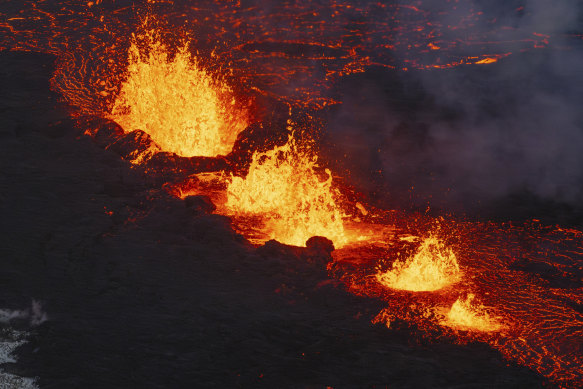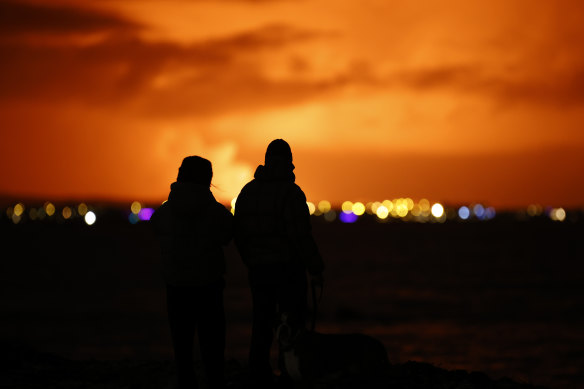By Egill Bjarnason and Cassandra Vinograd
After weeks of anticipation, a volcanic eruption in Iceland’s most populated area sent lava spewing into the night sky and pushed authorities into action. The eruption this week, which was larger than volcanologists had predicted, happened not far from an evacuated town and a power plant.
Iceland is no stranger to volcanic eruptions, and authorities quickly moved to reassure the public that there was no immediate threat to life. “We are prepared and remain vigilant,” President Gudni Johannesson wrote on the social platform X, formerly known as Twitter.

A close up of the southern active segment of the Grindavik volcano.Credit: AP
They also stressed that travel was not affected – a clear attempt to fend off concerns of a repeat of 2010, when an ash cloud from another eruption in Iceland snarled flights across Europe.
Here’s what to know about the eruption.
What happened?
The eruption began on Tuesday (AEDT), with fountains of lava pouring from a fissure within a volcanic system on the Reykjanes Peninsula, the most populated region in Iceland and home to its capital, Reykjavik. Helicopter video shared by Iceland’s Civil Defence showed steam rising from a glowing, snaking river of lava.
Volcanologists initially said that the eruption had occurred in one of the worst possible locations. The fissure, which is about four kilometres long, is not far from the Svartsengi power plant, a geothermal facility that supplies hot water to the whole peninsula. And it is about three kilometres from Grindavik, a town of more than 3500 that was evacuated last month after heightened seismic activity prompted concerns that an eruption was likely.
After flying over the eruption site, volcanologists said that the immediate situation appeared less dire than initially feared.
Are people at risk?
Volcanologists noted that the direction of the lava’s flow was unpredictable. Although the Icelandic Meteorological Office said on Wednesday (AEDT) that the eruption’s intensity “continues to diminish”, with the flow estimated to be about one quarter of what it was initially, it was not immediately clear how long it would go on.
“The fact that the activity is decreasing already is not an indication of how long the eruption will last, but rather that the eruption is reaching a state of equilibrium,” the meteorological office said in a statement.
Yet because the affected area had previously been evacuated, the eruption “does not pose immediate threat to people”, Iceland’s tourist board said. The area was closed to traffic, and the risk to nearby energy infrastructure was being assessed, Iceland’s government added in a statement.
Authorities nevertheless warned against getting too close, with Hjordis Gudmundsdottir, a spokesperson for the Department of Civil Protection, emphasising that this was “no tourist volcano”.

People watch as the night sky is illuminated by the eruption of a volcano on the Reykjanes peninsula of south-west Iceland.Credit: AP
Is it affecting travel and tourism?
Iceland’s authorities had raised the aviation alert to orange, because ash from a volcanic eruption could pose a risk to aircraft flying in the North Atlantic.
But as of Wednesday morning (AEDT), all flights to and from the country were operating on schedule, according to a statement from Iceland’s tourist board. It also noted that previous eruptions in the area had not affected air travel.
The European Union Aviation Safety Agency said it was monitoring the situation and stood “ready to take any action if required”.
Dave McGarvie, a volcanologist at Britain’s Lancaster University, said that “lava-dominated” fissure eruptions like this one tend to “produce little or no ash”.
The eruption did catch some in Iceland by surprise, given that concerns of an imminent eruption had diminished in recent days. The nearby tourist mecca, the Blue Lagoon, which had closed in November because of earthquake activity associated with potential volcanic eruptions, had reopened for guests on Sunday.
The site has since issued a statement saying that it would again temporarily shut down.
Overall, Sigurdur Ingi Johannsson, the country’s infrastructure minister, told RUV, the national broadcaster, “We seem to have been quite lucky,” adding, “we hope that will continue.”
How often do volcanic eruptions occur in Iceland?
Volcanic eruptions are not uncommon in Iceland, which has fewer than 400,000 residents and about 130 volcanoes. In just the past two years, there have been four eruptions on the Reykjanes Peninsula, the scene of the latest eruption and home to about two-thirds of Iceland’s population.
One of Iceland’s most memorable eruptions involved the Eyjafjallajokull volcano in 2010. Although it was relatively small and caused no fatalities, the impact was widespread because a resulting ash cloud grounded much of Europe’s air travel for more than a week.
Iceland straddles two tectonic plates, which are themselves divided by an undersea mountain chain that oozes molten hot rock.
Earthquakes occur when the magma pushes through the plates, and starting in late October, a rise in seismic activity was detected, with tens of thousands of earthquakes reported in the Reykjanes Peninsula. At one point there were as many as 1400 in a single 24-hour period.
That raised concerns that a significant eruption would soon occur. But when Grindavik was ordered evacuated on November 11, authorities said that the country was “highly prepared”.
“Iceland has one of the world’s most effective volcanic preparedness measures,” Iceland’s Department of Civil Protection and Emergency Management said on its website.
This article originally appeared in The New York Times.
Get a note directly from our foreign correspondents on what’s making headlines around the world. Sign up for our weekly What in the World newsletter.